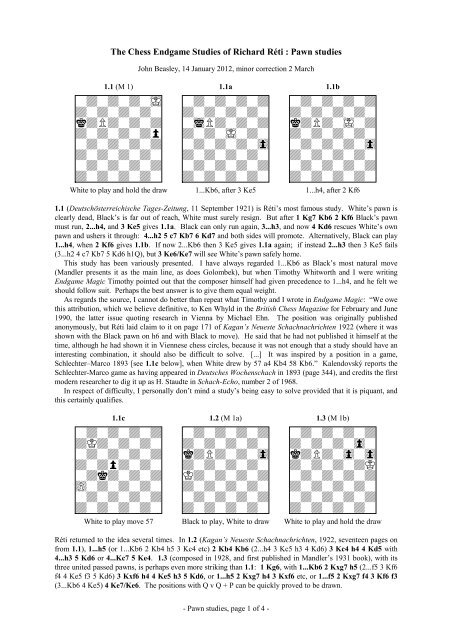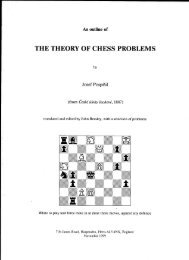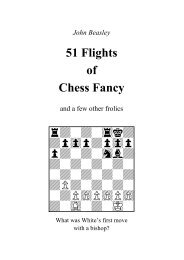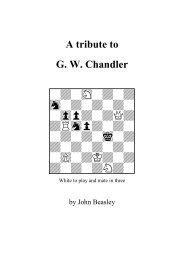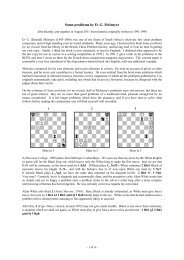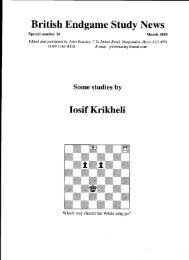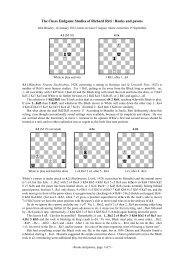Pawn studies - John and Sue Beasley
Pawn studies - John and Sue Beasley
Pawn studies - John and Sue Beasley
You also want an ePaper? Increase the reach of your titles
YUMPU automatically turns print PDFs into web optimized ePapers that Google loves.
The Chess Endgame Studies of Richard Réti : <strong>Pawn</strong> <strong>studies</strong><strong>John</strong> <strong>Beasley</strong>, 14 January 2012, minor correction 2 March1.1 (M 1) 1.1a 1.1bwdwdwdwI wdwdwdwd wdwdwdwddwdwdwdw dwdwdwdw dwdwdwdwkdPdwdwd wiPdwdwd kdPdwIwddwdwdwdp dwdwIwdw dwdwdwdwwdwdwdwd wdwdwdw0 wdwdwdw0dwdwdwdw dwdwdwdw dwdwdwdwwdwdwdwd wdwdwdwd wdwdwdwddwdwdwdw dwdwdwdw dwdwdwdwWhite to play <strong>and</strong> hold the draw 1...Kb6, after 3 Ke5 1...h4, after 2 Kf61.1 (Deutschösterreichische Tages-Zeitung, 11 September 1921) is Réti’s most famous study. White’s pawn isclearly dead, Black’s is far out of reach, White must surely resign. But after 1 Kg7 Kb6 2 Kf6 Black’s pawnmust run, 2...h4, <strong>and</strong> 3 Ke5 gives 1.1a. Black can only run again, 3...h3, <strong>and</strong> now 4 Kd6 rescues White’s ownpawn <strong>and</strong> ushers it through: 4...h2 5 c7 Kb7 6 Kd7 <strong>and</strong> both sides will promote. Alternatively, Black can play1...h4, when 2 Kf6 gives 1.1b. If now 2...Kb6 then 3 Ke5 gives 1.1a again; if instead 2...h3 then 3 Ke5 fails(3...h2 4 c7 Kb7 5 Kd6 h1Q), but 3 Ke6/Ke7 will see White’s pawn safely home.This study has been variously presented. I have always regarded 1...Kb6 as Black’s most natural move(M<strong>and</strong>ler presents it as the main line, as does Golombek), but when Timothy Whitworth <strong>and</strong> I were writingEndgame Magic Timothy pointed out that the composer himself had given precedence to 1...h4, <strong>and</strong> he felt weshould follow suit. Perhaps the best answer is to give them equal weight.As regards the source, I cannot do better than repeat what Timothy <strong>and</strong> I wrote in Endgame Magic: “We owethis attribution, which we believe definitive, to Ken Whyld in the British Chess Magazine for February <strong>and</strong> June1990, the latter issue quoting research in Vienna by Michael Ehn. The position was originally publishedanonymously, but Réti laid claim to it on page 171 of Kagan’s Neueste Schachnachrichten 1922 (where it wasshown with the Black pawn on h6 <strong>and</strong> with Black to move). He said that he had not published it himself at thetime, although he had shown it in Viennese chess circles, because it was not enough that a study should have aninteresting combination, it should also be difficult to solve. [...] It was inspired by a position in a game,Schlechter–Marco 1893 [see 1.1c below], when White drew by 57 a4 Kb4 58 Kb6.” Kalendovský reports theSchlechter-Marco game as having appeared in Deutsches Wochenschach in 1893 (page 344), <strong>and</strong> credits the firstmodern researcher to dig it up as H. Staudte in Schach-Echo, number 2 of 1968.In respect of difficulty, I personally don’t mind a study’s being easy to solve provided that it is piquant, <strong>and</strong>this certainly qualifies.1.1c 1.2 (M 1a) 1.3 (M 1b)wdwdwdwd wdwdwdwd wdwdwdwddKdwdwdw dwdwdwdw dwdwdw0wwdwdwdwd kdPdwdw0 kdPdw0w0dwdpdwdw dwdwdwdw dwdwdwdKwdkdwdwd Kdwdwdwd wdwdwdwd)wdwdwdw dwdwdwdw dwdwdwdwwdwdwdwd wdwdwdwd wdwdwdwddwdwdwdw dwdwdwdw dwdwdwdwWhite to play move 57 Black to play, White to draw White to play <strong>and</strong> hold the drawRéti returned to the idea several times. In 1.2 (Kagan’s Neueste Schachnachrichten, 1922, seventeen pages onfrom 1.1), 1...h5 (or 1...Kb6 2 Kb4 h5 3 Kc4 etc) 2 Kb4 Kb6 (2...h4 3 Kc5 h3 4 Kd6) 3 Kc4 h4 4 Kd5 with4...h3 5 Kd6 or 4...Kc7 5 Ke4. 1.3 (composed in 1928, <strong>and</strong> first published in M<strong>and</strong>ler’s 1931 book), with itsthree united passed pawns, is perhaps even more striking than 1.1: 1 Kg6, with 1...Kb6 2 Kxg7 h5 (2...f5 3 Kf6f4 4 Ke5 f3 5 Kd6) 3 Kxf6 h4 4 Ke5 h3 5 Kd6, or 1...h5 2 Kxg7 h4 3 Kxf6 etc, or 1...f5 2 Kxg7 f4 3 Kf6 f3(3...Kb6 4 Ke5) 4 Ke7/Ke6. The positions with Q v Q + P can be quickly proved to be drawn.- <strong>Pawn</strong> <strong>studies</strong>, page 1 of 4 -
- The chess endgame <strong>studies</strong> of Richard Réti -1.4 (M 2, with Artur M<strong>and</strong>ler) 1.4awdwdwiwddwdwdw0wwdwdwdw0dwdwdwdwwdwdwdw)dwdwdwdKwdwdwdwddwdwdwdwWhite to play <strong>and</strong> hold the drawwdwdwdwddwdwdw0wd cwdwdwdw0b adwdwdwdw Awdwdwdw)A B CC DdwdwdwdwwdwdwdwddwdwdwdwWhere the White king must go1.4 (Tijdschrift v. d. NSB, 1921) was a joint composition with Artur M<strong>and</strong>ler. M<strong>and</strong>ler gave a detailedexposition both in his 1931 book <strong>and</strong> in his 1970 book Studie, <strong>and</strong> I repeat the latter as I translated it in Depth<strong>and</strong> Beauty. He looks first at what is going to happen later in the solution, then works out what the early moveshave to be in order to create favourable conditions for it.1) Black’s move ...h5 comes into consideration only when the White king cannot reply by moving to g5.[Black will have to reply...g6 to defend the pawn on h5, his king being presumed to be already on f7 or perhapsh7, <strong>and</strong> now White will play Kf4 <strong>and</strong> Black cannot make progress even by taking the opposition.]2) The White pawn can make the first pawn move if the White king is already on e5 or f5, or if its advancewill leave White with the opposition. So as long as the pawns are in their present positions, Black cannot put thekings into opposition (either close or distant) because White will then draw by h5. [Suppose the White pawnadvanced to h5, but the kings only on f4 <strong>and</strong> f6. If White is to play, Ke4 lets Black in at once, <strong>and</strong> Kg4 allows...Ke5 turning White’s position in the usual way; but Black to play cannot make progress.]3) If Black plays ...g6 while his king is on the seventh rank, White must take up the distant opposition; if theBlack king is on the sixth rank, White must take up the close opposition; if the Black king has reached the fifthrank, ...g6 is always a winning move. [Suppose Black’s pawns on g6/h6. If Black has the opposition, close ordistant, he will eventually be able to advance <strong>and</strong> turn White’s position. If White has it, Black can take it byplaying ...h5, but if the kings are on say e4 <strong>and</strong> e6 this will not help him. If they are on e3 <strong>and</strong> e5, it will.]4) As long as the Black king has not reached the fifth rank, the opposition is harmful. If Black has it, Whitedraws by h5; if White has it, Black wins by ...g6. If the Black king has reached f6, the pawns still being wherethey are, White must prevent its advance to the fifth rank. Which move is correct, Ke4 or Kg4? Only Ke4.If White plays Kg4, giving the king configuration g4/f6, Black wins by 1...Ke5 2 Kh5 Kf4 3 Kg6 Kg4 4 Kxg7h5. But if the White king is on e4, White can meet ...g6 or ...Ke6 by Kf4. The squares e4/f6 (Aa in diagram1.4a, ignoring h5 for the moment) <strong>and</strong> likewise f4/e6 (Bb in 1.4a) mutually correspond, <strong>and</strong> the side which hasto move while the kings are in this position is in zugzwang: White to move loses, Black to move can only draw.5) After 1 Kg3 (Kg4) Kf7, the White king cannot move to the f-file. 2 Kf3 <strong>and</strong> 2 Kf5 would allow Black towin by 2...g6, <strong>and</strong> 2 Kf4 by 2...Ke6. So, from the diagram position, the Black king can play to f6 withoutWhite’s being able to play to e4 in reply. However, there is another square which corresponds to f6, <strong>and</strong> this ish5. If Black has to move in the position h5/f6, gaining the fifth rank does not help him: 1...Ke5 2 Kg6 Kf43 Kxg7 h5 4 Kf6! Kg4 5 Ke5 <strong>and</strong> draws. White to move in this position loses. So f6 <strong>and</strong> h5 are alsocorresponding squares.6) f7 <strong>and</strong> g4 (Cc in 1.4a, ignoring e3 for the moment) form a further pair of corresponding squares. If thekings are on these squares <strong>and</strong> White is to move, 1 h5 is met by 1...Ke6 2 Kf4 Kf6 (see point 2 above), 1 Kf5<strong>and</strong> 1 Kf3 by 1...g6 (point 3), 1 Kf4 by 1...Ke6 (point 4), <strong>and</strong> 1...Kg3 by 1...Kf6, since the White king has accessneither to e4 nor to h5 (points 4 <strong>and</strong> 5). If Black is to move, 1...g6 does not come into consideration (2 Kf3), nordoes 1...Ke6 (2 Kf4). 1...Kg6 fails against 2 Kf4 Kh5 3 Kg3 g6 4 Kh3, <strong>and</strong> 1...Kf6 against 2 Kh5 (point 5).7) This has led us to the opening move. 1 Kg4 is met by 1...Kf7, but White must bring his king closeenough to meet ...Kf6 by Kh5, <strong>and</strong> this leaves him no choice but 1 Kg3. Now White will meet 1...Kf7 by 2 Kg4.8) After 1 Kg3 Ke7 2 Kf3 Kf6 3 Ke4 Kf7 the White king is out of range of g4. However, there is anothersquare which corresponds to f7, <strong>and</strong> that is e3. From here, White preserves the options of playing Ke4 or Kf4 ifthe Black king returns to the sixth rank, <strong>and</strong> of taking the distant opposition if Black plays ...g6. On 4...Ke7,White keeps the distant non-opposition.9) The solution therefore unfolds 1 Kg3 Ke7 (if 1...Kf7 then 2 Kg4 Kf6 3 Kh5 etc) 2 Kf3 Kf6 (2...Ke63 Kf4 Kf6 4 h5, 2...g6 3 Ke3) 3 Ke4 Kf7 (3...Ke6 4 Kf4, 3...Kg6 4 Kf4) 4 Ke3 <strong>and</strong> either 4...Ke7 5 Kf3 or4...g6 5 Kf3.The computer had only a trifling comment to make on this impressive piece of analysis: at the end of themain line, with the kings on e3/e7, White needn’t persist with the distant non-opposition, he can play h5 at once.- <strong>Pawn</strong> <strong>studies</strong>, page 2 of 4 -
- The chess endgame <strong>studies</strong> of Richard Réti -1.5 (M 3) 1.5a 1.5bwdwdkdwd wdwdwdwd wdwdwdwddwdwdwdw dwdwiwdw dwdwiwdwwdw0wdwd wdw0wdKd wdwdwdwd0wdwdwdK 0wdwdwdw 0wdpdKdwPdwdwdPd PdwdwdPd PdwdwdPddwdwdwdw dwdwdwdw dwdwdwdwwdwdwdwd wdwdwdwd wdwdwdwddwdwdwdw dwdwdwdw dwdwdwdwWhite to play <strong>and</strong> win 1 Kg6, after 1...Ke7 Main line, after 4 Kf51.5 (Berliner Tagblatt, 1923) was dedicated to the memory of Gyula Breyer. Try the obvious 1 Kg6, crowdingBlack as far as possible: no, 1...Ke7 (see 1.5a) 2 Kf5 Kf7 3 Ke4 (or 3 g5 d5 4 Ke5 Kg6 5 Kxd5 Kxg5) Kg64 Kd5 Kg5 5 Kxd6 Kxg4, <strong>and</strong> Black will just have time to get back to the drawing square c8. White needs togain a tempo, <strong>and</strong> paradoxically the way to do so is by losing one: 1 Kg5 Kf7 (if 1...Ke7 then 2 Kg6 at once)2 Kf5 Ke7 3 Kg6, giving 1.5a with Black to play. If now 3...Ke6 then 4 g5 followed by 5 Kh7, <strong>and</strong> White willpromote with check; if 3...Kf8 then 4 Kh7, <strong>and</strong> White will give check on g7 <strong>and</strong> then promote while the Blackpawn is still at d3. Hence 3...d5, <strong>and</strong> the natural move is 4 Kf5 (see 1.5b). If now 4...Kf7 then 5 Ke5 Kg66 Kxd5, <strong>and</strong> White is a crucial tempo ahead of the drawing line 1 Kg6 Ke7 2 Kf5 Kf7 3 Ke4 Kg6 4 Kd5 Kg55 Kxd6 (Black has had to spend a tempo playing ...d5, <strong>and</strong> this has enabled White to capture the pawn by Ke5<strong>and</strong> Kxd5 instead of having to go round via e4); if instead 4...Kd6 then 5 g5, after which 5...Ke7 6 Ke5 Kf77 Kxd5 again leaves White a crucial tempo ahead of the previous drawing lines <strong>and</strong> 5...d4 6 Ke4 Ke6 7 Kxd4 isno better. By playing to reach 1.5a with Black to move, White has sacrificed one tempo; but in the subsequentmanoeuvrings, Black becomes two tempi worse off.Breyer (1893-1921) was closely associated with Réti. Not only were they among the leaders of the so-called“hypermodern” school, but they were the producers of the short-lived Bratislava games-<strong>and</strong>-puzzles journalSzellemi Sport. In the English edition of Modern Ideas in Chess, where this journal is curiously mistitled, Rétinames Breyer as its sole editor, but if I have interpreted the translations in my daughter’s Hungarian dictionarycorrectly its masthead listed Breyer as “responsible editor” <strong>and</strong> Réti as “principal colleague”. Many years ago,Bedrich Formánek sent me copies of the first five issues (1 April 1921, 15 April, 1 May, 1 June, 1 July),apparently all that there were, courtesy of the library of Bratislava University, but unfortunately 90 per cent ofthe text is in Hungarian, <strong>and</strong> the rest is in German which for me is little better. Any detailed account of it inEnglish will therefore have to be left to somebody else.Szellemi Sport devoted a significant proportion of its space to chess, <strong>and</strong> in Modern Ideas in Chess Rétidescribes it as having contained the famous Breyer position in which White draws not by normal means but byplaying a non-capturing piece move <strong>and</strong> then proving that fifty moves must have passed since the last capture orpawn move. However, I cannot find this in the five issues I have seen (I can underst<strong>and</strong> the chess diagrams evenif I cannot read the text), <strong>and</strong> in fact it seems first to have appeared after Breyer’s death in T. R. Dawson’s“Fairy Chess” column in the February 1922 issue of the Chess Amateur. Dawson, who described it as “the mostglorious retro I have had the privilege of yet printing”, said that it had been sent to him by “the Budapest circle”having been composed during the war. It was shown many years later that the position was slightly unsound, inthat with a different approach in the play up to the diagram only 49 moves need have been played, but a simplechange to the position allowed the crucial fiftieth move to be reinstated (EG 28, April 1972, quoting Problem124-126, March 1969). Extreme retro tasks like this are often slightly unsound as originally published, <strong>and</strong> thegenerous <strong>and</strong> proper custom is to continue to credit the achievement to the first person to realise the essentials ofthe task even if his realisation is subsequently found to be faulty in minor detail.- <strong>Pawn</strong> <strong>studies</strong>, page 3 of 4 -
- The chess endgame <strong>studies</strong> of Richard Réti -1.6 (M 4) 1.6a 1.6bwdwdwdkd wdwdwdwd wdwdwdwd0wdwdwdwwdwIwdpddPdwdwdpwdwdwdw)dwdwdwdw0wdwdwdwwdwdwdwddPdwdwipwdwdKdwddwdwdwdw0wdwdwdwa b a b cwdwdwdpdc ddPdwdwdpA Bwdwdwdw)C DdwdwdwdwA Bwdwdwdwd wdwdwdwd wdwdwdwddwdwdwdw dwdwdwdw dwdwdwdwWhite to play <strong>and</strong> hold the draw 1 Ke5, after 4/5...Kxg5 Where the White king must go1.6, composed in 1929, is another study that was first published in M<strong>and</strong>ler’s 1931 book. When I was writingthe endgame study column in the French composition magazine diagrammes, one of my solvers said that hepreferred solving win <strong>studies</strong> to draws because he could look forward to a clear-cut climax; the play in a drawstudy (unless something like a snap stalemate was involved) often seemed to finish rather inconclusively. Réti’sdraw <strong>studies</strong>, in contrast, normally end in positions where the stronger side’s inability to make further progresshas become obvious.Here, Black to play would win offh<strong>and</strong> by 1...g5. The threatened follow-up move 2...g4 would give him aprotected passed pawn, so White must capture, 2 hxg5, <strong>and</strong> after 2...h4 the h-pawn is out of range. Can Whiteignore this <strong>and</strong> play 1 Kc6? No, there would follow 1...g5 2 Kb7 g4 3 Kxa7 g3, <strong>and</strong> Black will promote withcheck while White’s pawn is still at b7. However, if Black’s king were at f6 instead of g8, this line would work,because after 1 Kc6 g5 White could play 2 hxg5+, Black would have to spend a move getting his king out ofcheck, <strong>and</strong> his eventual promotion would be on h1 instead of g1 (2...K~ 3-4 Kxa7 h3 5-6 b7 h1Q 7 b8Q). So aslong as White’s king is within reach of c6, the square f6 is unavailable to Black’s king.At present, however, Black’s king is not on f6, <strong>and</strong> so White must play 1 Kd5 or 1 Ke5 to deal with thethreat of ...g5. Without the pawns on b5 <strong>and</strong> a7, the position would now be a dead draw; White would simplymark time on e4 <strong>and</strong> f4, <strong>and</strong> Black could not make progress even by taking the opposition. With them, however,Black can hope to create an outside passed pawn on the h-file, <strong>and</strong> to gain sufficient time by diverting White’sking to deal with it to be able to force the win on the other wing. If White plays 1 Ke5, he can indeed do this:1...Kf7 2 Ke4 (if 2 Kf4 then 2...Kf6 at once, while if 2 Kd5 then 2...g5 3 hxg5 Kg6 4 Ke4 Kxg5 <strong>and</strong> we have1.6a as below) Ke6 3 Kf4 Kf6 4 Ke4 (if White retreats to the third rank, Black takes the opposition <strong>and</strong> turnsWhite’s position at once) g5 5 hxg5+ Kxg5 (see 1.6a) 6 Kf3 Kf5 7 Kg3 Ke5 8-9 Kxh5 Kc5 10 Kg4 Kxb5, <strong>and</strong> ifWhite plays 11-13 Kd1 to try <strong>and</strong> reach the drawing square c1 Black can play to b2 <strong>and</strong> hold him off.So the move must be 1 Kd5, when there might follow 1...Kg7 2 Ke4 Kf6 3 Kf4 Ke7 4 Ke3 or 1...Kf7 2 Ke5Ke7 3 Kd5 Kd7 (if instead 3...Kf6 then 4 Kc6 etc as in our opening discussion) 4 Ke5 Kc7 5 Kd5 etc. All thisis summarized in diagram 1.6b, <strong>and</strong> we see that if the Black king is on e6 or f6 White must take the closeopposition on the fourth rank, whereas if Black is on e7 or f7 White must take either the non-opposition on thefifth rank or the distant opposition on the third. But once White has played to one of the squares marked indiagram 1.6b he can continue to do so indefinitely (unless Black moves to f6 when White is on d5, in which caseKc6 forces the draw at once), while typical consequences of failing to do so have been seen in the various lineswhich followed 1 Ke5.And we may notice the curiously two-edged nature of the pawns on b5 <strong>and</strong> a7. Without them, the positionwould be hopelessly drawn. Their presence gives Black reason to hope for a win, but by poisoning the square f6against the Black king they enable White to hold out after all.- <strong>Pawn</strong> <strong>studies</strong>, page 4 of 4 -


